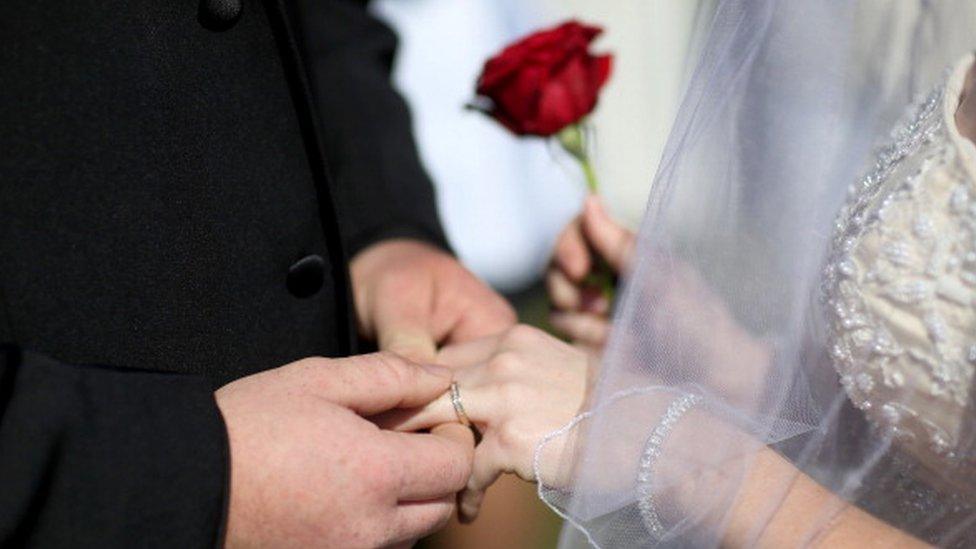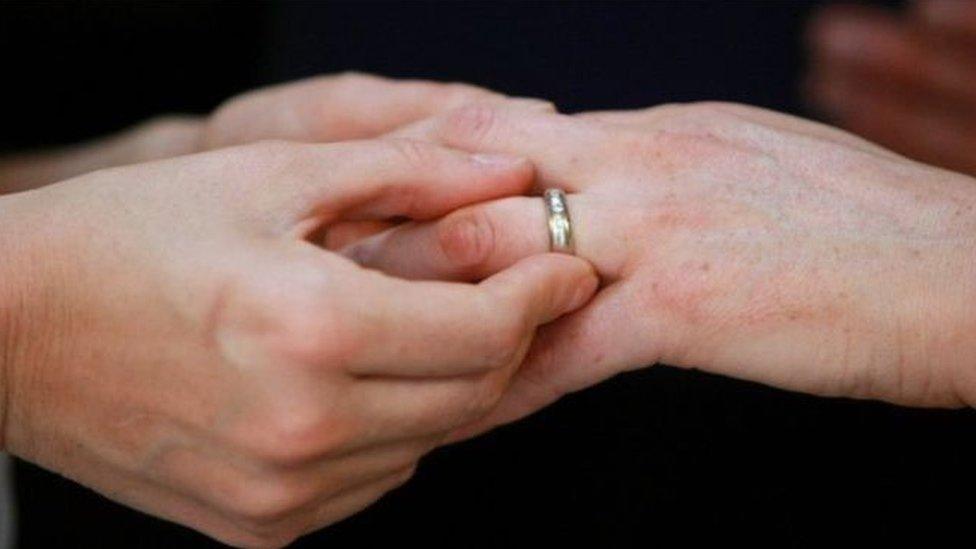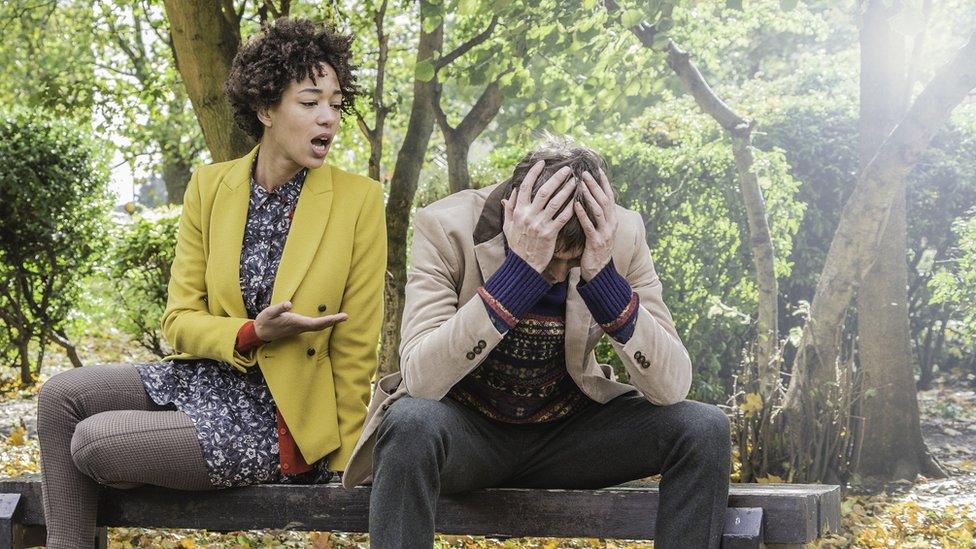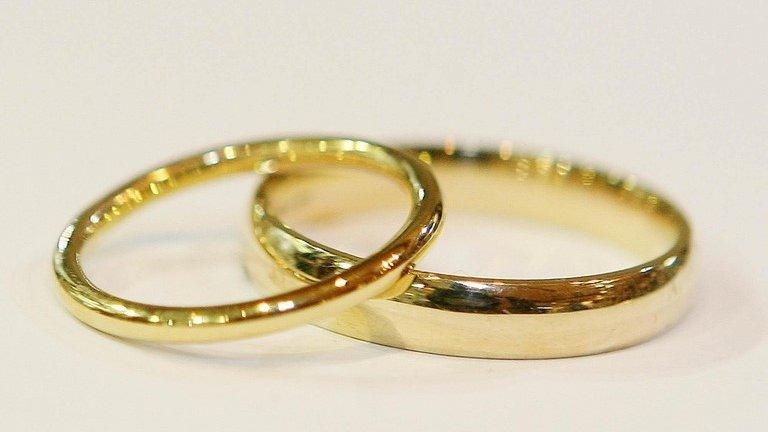Reality Check: Are we living happily ever after?
- Published

Fewer people are getting divorced in England and Wales, figures released in June show. Is this a cause for celebration? Reality Check asks whether we are becoming a nation of couples living happily ever after.
In 2015, the most recent year we have figures for, external, 101,055 opposite sex couples divorced in England and Wales, according to figures from the Office for National Statistics (ONS).
This was a fall of 9.1% from the year before and down 34% from a peak in 2003.
But the important figure to look at is the rate. This is the number of every 1,000 people married who are getting divorced and will indicate how stable marriage is. The 2015 figures show that for both men and women the rate dropped to 8.5 per 1,000, from 9.3 the year before. You can see from the graph below that this rate has continued to fall since a peak in 2004.
This suggests that marriage has indeed become more stable. So are we a nation full of happily married couples?
Tying the knot
Well, for the past 45 years, the number of people of the opposite sex getting married has largely been falling.
In 2014, the last year for which we have data, external, there were 247,372 marriages between opposite sex couples in England and Wales. This was slightly up on the previous year, 2013, which saw the lowest marriage rate on record. Calculated per 1,000 population, the rate was 22.5 for men and 20.4 for women.
The ONS think this was probably because of people avoiding the "unlucky" number 13. But there has been a general trend away from tying the knot that began from a peak in 1972, when there were 426,000 marriages.
Living in sin
So while marriage can be seen as more stable, fewer of us are tying the knot. This decline can be explained by a growing number of people who are single and a rise in the number of people living together without getting married.
Cohabitation may no longer be seen as shamefully living in sin, but figures are harder to collate because, unlike marriage, there is no official record. Instead, we need to look at large household surveys. Although data is not directly comparable with annual marriage and divorce rates, this can provide a useful picture.
Figures released by the ONS on Thursday, external show that 9.8% of the population of England and Wales were cohabiting in 2016. This is up from 6.8% in 2002.
This rise in cohabitation can also be seen in the ONS Families and Households UK survey, external. This is a UK-wide report based on the Labour Force Survey , externalwhich interviews 40,000 households every quarter. Here, the ONS definition of family includes same and opposite sex couples with and without dependent children.
From their 2016 sample, the ONS calculated that there were 3.3 million cohabiting families across the UK, more than double the 1996 figure of 1.5 million families. This makes cohabiting the fastest growing family type over the past two decades.
Of course, it will take time before this rise in cohabitation becomes evident in the population as a whole. In fact, married couples remain the most common form of family type at just under 12.7 million. Again, this includes couples with and without dependent children.
To marry or not to marry?
So the question becomes; are people living together happily ever after, even though they aren't married?

We do not know how many people "divorce" from a cohabiting relationship each year but one way to build a picture of whether cohabiting couples remain happily together, is to compare them with married couples.
In other words, are people who live together more or less likely to end the relationship than those who marry?
Which is more stable - marriage or cohabiting?
Finding an answer to this question involves using longitudinal household surveys that gather data over time.
One useful place is The Millennium Cohort Study, external, which follows the lives of nearly 19,000 children born in the UK in 2000-2001.
An IFS study of this data, external found that 9% of couples, married when their child was born, were no longer together when the child turned five, compared with 27% of cohabiting couples.
This suggests that cohabiting couples with children are more likely to "divorce" than married couples.
Harry Benson, of the Marriage Foundation, who advocates for marriage, and Prof Stephen McKay, from the University of Lincoln, looked at another large dataset from Understanding Society,, external which surveys 40,000 UK households.
They found that the break-up rate for parents, external of children who were 14 or 15 in 2009-10 was 24% if the parents were married before the child was born. This rose to 69% in cases where the parents were not married before the child's birth and remained unmarried.
However, both the Millennium Cohort Study and Understanding Society only have data for cohabiting couples with children. For cohabiting couples without children, we simply do not have good data.
So are we a nation living happily ever after?
Without complete data on cohabitation, it is impossible to know how many unmarried couples continue to live together.
However, the declining divorce rate suggests that marriage itself is becoming more stable.



- Published13 July 2016

- Published25 May 2016

- Published24 March 2014
